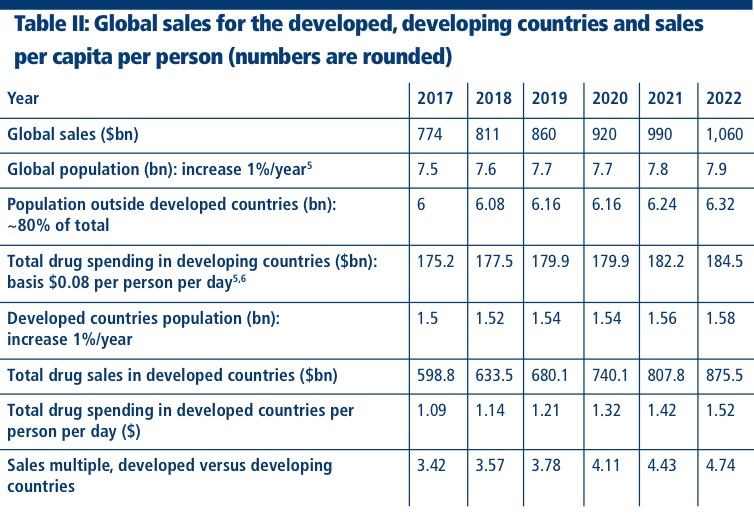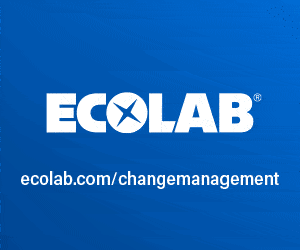World Preview 2017, Outlook to 2022, published by EvaluatePharma, is an interesting report.1 There are similar reports published every year and, from a sales perspective, these reports might be useful to some. However, I have not yet seen a report that translates or equates sales numbers to number of patients served and/or affordability. As developed countries (haves) and developing countries (have nots) are two distinct customer bases, it would be useful to understand drug expenditure spending per person, per day, for each market. The resulting numbers could be used to understand and develop plans to improve global sales and the affordability of drugs. These numbers might also tell us whether the projected sales from other forecasters can be achieved, where the sales could come from and what steps need to be taken to achieve the projected sales and make the product more affordable (Figure 1).

Numbers from Figure 1 are listed in Table I and demonstrate what is required to meet sales projections. The numbers in Table I seem to be realistic and obtainable; however, the projected sales increase for each year is equivalent to the revenue of one or two of the top five pharmaceutical companies for the next 5 years.2 Therefore, achieving these numbers is easier said than done. An earlier alternate study reviewing drug prices and number of patients might be of interest.3

Table II has been created using the sales forecast from Table I. The population of the developed and the developing countries and average sale per person per day in the developing countries are used to determine the sales for the developed countries.4 Average sales per day per person for the developing countries, including the rest of the world, might be considered low; but, using the available data and extrapolating it, it’s the best number I could derive.5,6 I am comfortable with the developed numbers.

In my travels and personal experience, I have seen that prices for prescription and generic drugs in developing countries are significantly lower than the prices for the same prescriptions in developed countries. However, even with low prices, people in developing countries have to decide between food for the family and drugs for the ill as a result of low incomes.7 Based on the sales increase from 2008 to 2016 (Figure 1), one can speculate that projected 2022 sales will mostly come from developed countries, rather than developing countries. Orphan drugs (less than 200,000 patients per disease) are going to be an ever-increasing source of revenue and, as a result, Brand Pharma has shifted its focus from drugs for the masses to orphan drugs. It is well-known that orphan drugs increase revenue dramatically as they are very highly priced and also highly profitable. New drugs are being introduced continuously, but most are only marginally better than the drugs already on the market and are equally expensive.8 As a result, they are unaffordable to many and frowned upon even by physicians and healthcare systems. For example, PCSK9 is a class of drugs for cholesterol that will have a very limited market.
In recent years, there has been a focus on increasing the prices of drugs rather than developing affordable drugs. “Rather than compete by lowering net prices, the drug companies compete by raising list prices,” notes Berman, of Hagens Berman Sobol Shapiro, making an interesting point about how pharmaceutical companies raise revenue.9
Affordability in the developing countries is critical for sales. Merck, in 2008, had to significantly lower the price of Januvia in India, a country with the highest population of individuals with diabetes.10 Affordability forced patients to stay with metformin hydrochloride or other drugs compared with Januvia. HIV drugs were unaffordable to many in Asia and Africa until Cipla intervened and the Gates and Clinton Foundations supported the move, although they remain expensive in the United States.11 If infectious diseases were not present in developed countries, it’s possible that some companies may not have developed the necessary drugs.
HCV drug Sovaldi, sold in the US at $84,000, is sold in India and other countries for less than 200 times the US sale price by Gilead, through its arrangements with local pharmaceutical companies.12 Compulsory licensing is part of the WTO agreement and has been used to lower drug prices in developing countries, which is not ideal for branded drug companies.13 However, affordability is critical and branded companies occasionally forget that some of their customers cannot even afford food at times.7 Another important fact that brand companies forget is that they have more patients in need of the drug in developing countries than in developed countries. Economies of scale can lower costs and improve profits!
Even with an excellent mutually subsidised healthcare system, it is well known that many patients do not take their drugs as prescribed.14–16 Table II shows that sales in developed countries are going to stay at about four times the sales of developing countries. This is very telling, especially when the population of the developing countries is about four times that of the developed countries. This lopsided arithmetic suggests that pharma companies have tremendous opportunities to increase their sales if drugs can be made more affordable.
Potential ways to increase sales and improve affordability
With the current push to make drugs more affordable in the United States and in other developed countries, pharmaceutical companies will be challenged to increase their revenue. Beyond the sales of high priced orphan drugs, the availability of medicines to 80% of the population outside the developed countries is critical to driving sales. If this population cannot afford the necessary drugs, it is going to be a challenge to achieve the projected sales.
Developed countries have the highest usage of drugs. Pharmaceutical sales in the United States are nearly half of developed country sales.17 Marginally better drugs are taking up significant financial and human resources and have less than expected returns. For sales to increase, new drugs have to be substantially better than the current ones on the market; however, affordability will always play a significant role.
There are a few ways that sales can be improved and the options are discussed below; however, these will not suit the business model of each company. Effort has to come from within as opposed to outside.
Increase prices: This could be considered to be the easiest way, but will have the highest negative publicity, along with lawsuits.9 Table III shows the net effect of such increases. Sales shortfalls from the projected numbers will still be there — even when the average price is increased by 1% per person per day.

Lower costs: There are many different areas wherein costs can be lowered.18 They will come from improvements in regulation and manufacturing technologies and processes. Monies saved will more than offset the investment costs necessary for such projects. Economies of scale can also significantly reduce costs and improve product quality. Lower prices could increase the patient base, resulting in higher sales revenues.
Reduce regulatory costs: FDA’s application, review and approval process for NDAs and ANDAs is based on analysis and reanalysis of the application, and this process is similar to a manufacturing process. FDA and regulators have suggested that companies should incorporate QbD (quality by design) practices into their manufacturing processes. Perhaps the regulators should show the industry how incorporating QbD practices into their own workings will improve application approval quality, leading to reduced approval time and associated costs. Recent efforts have been made to shorten the filing and approval time.19–21 Continuous improvement effort is needed. Industry should not be told to improve their practices; the effort should come from within (quality by desire) as they reduce drug approval times.
Lower manufacturing costs: There are many excellent ways to lower manufacturing costs. The fundamentals of chemical engineering and chemistry that are judiciously practiced in the chemical and petrochemical industries have to be applied. Cross-fertilisation is necessary. Unit processes and unit operations can be significantly improved. We have to exploit the physical and chemical behaviour of the chemicals, along with existing commercially available equipment, to simplify reactive and formulation processes.22,23
A simple example is to ensure that no more than two solvents, one being water, are used in the process. Multiple solvents suggest that the manufacturing process has not been optimised and is similar to laboratory synthesis, which is generally expensive because of poor conversion yields and methodology. Exploiting melting point differences, mutual solubility and density differences can simplify processes and make them more cost-effective.24
There are other ways that manufacturing costs can be lowered, which are process and product volume dependent. An important issue, asset utilisation, is often overlooked. In the manufacture of active ingredients and formulations, asset utilisation is generally less than 50%.25 Even though this reference is old, not much has changed! Poor asset utilisation raises product costs and is an opportunity to improve profits.
Supply chain: Inventory turns better than pharma’s current 1–2 turns make a big difference on business. They force a better control of raw materials, work in process and finished goods inventories. Cash flow improvement has a big financial impact on costs. A lot of these suggestions can be achieved if we have excellent economic processes.

Process waste: Better processes have higher yields and lower costs. Controlled processes produce quality products from the start, rather than produce products through repeated analysis (aggravation). A better five-step process with 95% yield at every step would have about 77% yield, compared with a similar process delivering a yield of 14% if each step had an initial yield of 67%. Higher yields reduce product cost and reduce the burden of environmental remediation. And, there’s another benefit of high yield. We have to remember that most of the drugs — even though they are fine/specialty chemicals — are highly toxic and they kill disease-causing bacteria to cure patients. Thus, processes with low conversion yields and waste that is not properly disposed of can have significant impact on aquatic, land and human life.
Making drugs affordable is the best long-term way to improve total sales in developing countries. Because of the income differences between developed and developing countries, differences in drug processing will remain for the foreseeable future. Economies of scale and better manufacturing technologies can make drugs affordable and increase sales.26 However, to achieve all this will require business model review and change. It is not an easy task for an industry that has not aggressively embraced change and innovation. Their focus has always been on new drug development and marketing; drug affordability is an unknown area.

References
- http://info.evaluategroup.com/rs/607-YGS-364/ images/WP17.pdf.
- www.pharmexec.com/pharm-execs-top-50-companies-2017.
- G. Malhotra, “Manufacturing Technologies and Their Part to Achieve Future Pharmaceutical Sales,” Chemica Oggi/Chemistry Today 33(5), 28–31 (2015).
- http://ow.ly/vs6i30eUVgv.
- www.worldometers.info/world-population.
- www.pharmexec.com/pharmerging-future.
- https://pharmachemicalscoatings.blogspot.com/ 2011/06/drug-prices-food-vs-medicine-difficult.html.
- www.nytimes.com/2017/06/30/upshot/high-drug-prices-are-bad-cutting-them-could-be-worse.html?emc=edit_tnt_20170630&nlid=3903033&tntemail0=y.
- www.bloomberg.com/news/articles/2017-06-29/the-crazy-math-behind-drug-prices.
- www.livemint.com/Companies/bQMFNMPw2lUm 49D0lOFEQI/Merck-prices-diabetes-drug-at-fifth-of-US-rate.html.
- www.nytimes.com/2001/02/07/world/indian-company-offers-to-supply-aids-drugs-at-low-cost-in-africa.html.
- www.chicagotribune.com/business/ct-drug-price-sofosbuvir-sovaldi-india-us-20160104-story.html.
- www.wto.org/english/tratop_e/trips_e/public_health _faq_e.htm.
- www.npr.org/sections/health-shots/2017/03/15/ 520110742/as-drug-costs-soar-people-delay-or-skip-cancer-treatments.
- www.wsj.com/articles/patients-struggle-with-high-drug-prices-1451557981.
- www.health.harvard.edu/blog/millions-skip-medications-due-to-their-high-cost-201501307673.
- http://trade.gov/topmarkets/pdf/Pharmaceuticals_ Executive_Summary.pdf.
- http://eu.wiley.com/WileyCDA/WileyTitle/productCd-0470487542.html.
- https://pharmachemicalscoatings.blogspot.com/ 2016/05/can-senate-and-house-bills-s2615-and-hr.html.
- https://pharmachemicalscoatings.blogspot.com/ 2017/03/can-review-and-approval-process-for.html.
- https://pharmachemicalscoatings.blogspot.com/ 2017/05/road-maps-for-simplification-of-anda.html.
- G. Malhotra, “Focus on Physical Properties to Improve Processes,” Chemical Engineering 119(4), 63–66 (2012).
- https://pharmachemicalscoatings.blogspot.co.uk/ 2017/03/process-simplification-and-art-of.html.
- www.juran.com/elifeline/elifefiles/2009/09/Cost-of-Poor-Quality.ppt.
- www.pharmamanufacturing.com/articles/2007/144.
- https://pharmachemicalscoatings.blogspot.co.uk/ 2017/07/batch-continuous-or-fakefalse.html.




